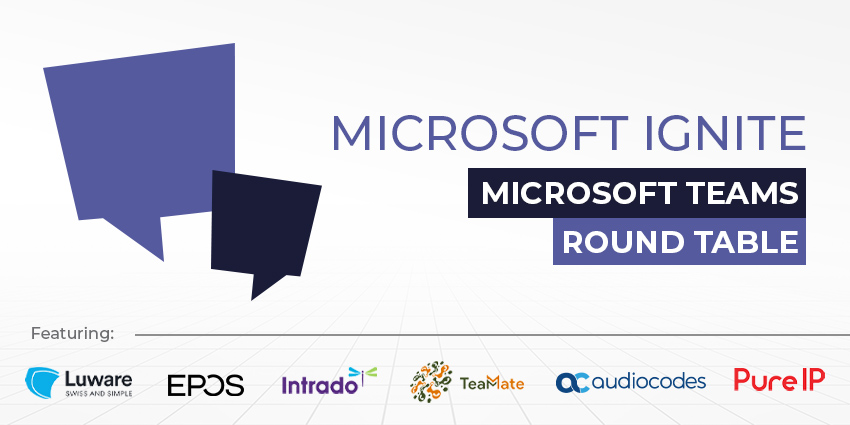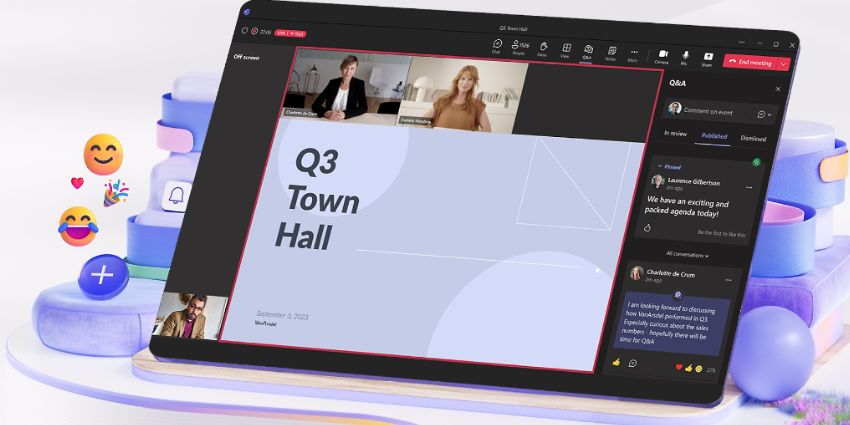It’s Ignite month, and we have seen an exciting spate of news across the first two weeks of March 2021. This is poised to be a crucial year for the company, as it strengthens its Teams value proposition further for continued WFH and the gradual rise of hybrid work.
Microsoft is coming out of a particularly successful quarter in Q4, 2020, where it crossed the 115 million DAU mark. The pressure is on the company to not only continue this incredible momentum (almost historic when compared to its nearest collaboration competitors like Slack) but also set new benchmarks – especially in categories like hardware and immersive tech, where it is lagging behind.
So, we weren’t surprised that two of the most important bits of news coming from Ignite were the introduction of the Operator Connect feature for Teams and the launch of the all-new Microsoft Mesh. These two announcements tackle two ends of the innovation spectrum, as one delivers a feature that users probably needed yesterday, while the other ushers in truly futuristic (and dare we say industry-first) capabilities.
We spoke to six experts from leading UC and collaboration companies to capture key industry viewpoints on these announcements. In this edition of the UC Today round table, we present insights from:
- Philipp Beck, CEO at Luware
- Cynthia Smith, Strategic Alliance Manager, Americas – Microsoft at EPOS
- Marcus Schmidt, Vice President of Product Management, Intrado
- Micah Singer, Managing Director, TeamMate Technology
- Andy Elliot, VP, Marketing, AudioCodes
- Gary Forrest, CEO at Pure IP
Here’s what they had to say.
Microsoft Operator Connect
Our reporting on the launch of Operator Connect has garnered a lot of traction, making the article the most viewed piece of news on UC Today that week. The question was:
What do you think of the new service and how do you predict it will impact the marketplace?
Operator Connect is the new service for Teams that will let customers quickly enable PSTN calling using their existing infrastructure from non-Microsoft telephony operators. Depending on where you’re situated, you could connect your telephone lines from BT, Deutsche Telekom, Intrado, NTT, Nuwave, Orange Business Services, Pure IP, Rogers, Swisscom, TATA, Telenor, or Verizon, and start using PSTN calling within Teams without any hassles. This is a major improvement on the existing calling capabilities in Teams, and our experts echoed this view.
Philipp Beck, CEO at Luware

Philipp Beck from Luware spoke about the specific use case where Operator Connect could play a significant role for Teams customers. And this would prove beneficial for the company as well, driving up their user numbers. “For many customers, Microsoft Calling Plans are not an option, e.g., when they already have a contract with a telco provider, including other services such as mobile contracts. Operator Connect is a great option for customers to get their PSTN numbers into Teams fast,” he said.
Further, companies eager to launch contact centres on Teams and provide customer service through Teams telephony will now find it much easier to get started.
“With Operator Connect, they can get their telephony, including customer service and contact center lines, up and running with Teams in a very fast manner. This allows them to transition their PBX to Teams easily. They gain momentum and speed in their transformation to the modern workplace,” he said, adding that “with Teams as a company-wide communication and telephony solution, they can fully leverage the power of the tool – also in customer service.”
We are potentially looking at greater Teams penetration in new regions and new customer segments, where the dependency on local carriers had previously held back adoption.
Cynthia Smith, Strategic Alliance Manager, Americas – Microsoft, EPOS

Cynthia Smith from EPOS agreed with Beck and emphasised the value of the new service in a hybrid working world.
“Microsoft introducing Operator Connect augments the modern Teams calling experience with the flexibility of choosing from participating operator partners. The simplicity of the new offering will expand the user audience and increase Teams Calling adoption. Easy implementation and the benefits of seamless UC integration add incremental business value. By enabling hybrid workspaces, users stay connected and focused on their meeting and collaboration,” she said.
The shift to remote work has definitely constricted our usual options when it comes to internal and external communication. With Operator Connect, Microsoft Teams gets a little closer to the traditional office-based communication environment that so many of us are still used to, and several organisations still prefer.
“Just like customers prefer having a variety of choices in EPOS Teams-certified audio devices, they will also appreciate having more opportunities to connect to Teams via Operator Connect,” she added.
Ultimately, it’s all about that extra bit of choice, says Smith.
Marcus Schmidt, Vice President of Product Management, Intrado

Intrado’s Marcus Schmidt discussed the launch from three perspectives: more opportunity for partners, more flexibility for customers, and greater control for IT.
The introduction of Operator Connect will necessarily come with a more expansive partner network and several carriers like BT, Verizon, Telenor, and Tata are already onboard. “From a partner perspective, I think this new program really highlights Microsoft’s shift towards a more partner-friendly environment. It’s unclear exactly how this will impact field-level engagement, but all signs point to Microsoft leveraging this program to further drive their sellers to work with partners,” Schmidt told us. He also pointed out that because of the catalysts that have driven the digital transformation faster than expected, providers like Microsoft need partners and services built around their offerings to help stay ahead of the curve.
“For years, customers have been demanding more third-party options when it comes to the features and functionalities that keep day-to-day operations afloat,” he also mentioned. For them, it’s all about having the best of both worlds – their favourite carrier, combined with Microsoft’s industry-leading Teams UI.
Finally, IT teams can gain from the availability of on-premise carrier systems alongside Microsoft’s cloud-based services. However, Schmidt recommends that customers consider partnering with an experienced telephony provider to keep up with any infrastructural or process alterations. “Putting all the eggs in one basket (so to speak) makes IT leaders nervous,” Schmidt said.
“There is no denying that cloud solutions help IT teams keep up with the ever-changing needs of their companies, but they are only as nimble as the provider. Microsoft can improve that ability by working closely with partners like Intrado.”
Micah Singer – Managing Director, TeamMate Technology

TeamMate Technology’s Micah Singer mentioned that Operator Connect signals a renewed focus from Microsoft on Teams calling capabilities, and it could find massive traction among carriers worldwide.
“I thought Microsoft was serious about calling services when they released Direct Routing. With Operator Connect, I know they are serious. They have taken another commodity service – SIP Trunks and made it easy for businesses to consume while also controlling admittance and ‘taxing’ use. Every SIP Trunk provider will want to be included. Those that have created a special recipe or automated integrations will lose their advantage.”
Singer also suggested that Operator Connect could only be the beginning. There are opportunities for tighter integrations between Teams and traditional PBX calling in a manner that organically ties the non-cloud telephony experience with platform-based collaboration. “Operator Connect, if executed well, will become a huge marketplace for SIP Trunks. Now, Operators needs to do something more unique like meaningfully integrate their PBX into Microsoft Teams – not just commodity calling and DID/DDIs.”
Andy Elliot, VP Marketing, AudioCodes

Andy Elliot from AudioCodes calls this an “interesting move,” one that could open up Teams for regions where local carrier dependency is unavoidable. Smaller businesses would especially benefit, as most small-to-mid-sized organisations are generally reluctant to abandon their existing telephony infrastructures or ongoing contracts with trusted local operators.
“Operator Connect is an interesting move by Microsoft. It empowers IT Managers and, in a way, democratises the SIP trunking and calling plan market for Teams by making it easier for customers to select their preferred provider directly within the Teams Admin Portal. We see this simplicity as being especially valuable in the SMB segment,” Elliot noted.
Elliot spoke about how AudioCodes had seen a lot of interest among customers when it comes to direct routing. Operator Connect is only an extension of this, he believes, and will only lead more customers to increase their adoption of Teams calling.
“At AudioCodes, we are positive about Operator Connect – it validates the important role that Direct Routing plays in the Teams voice market and underpins the importance of certified SBCs both for the service provider and end customer. As a leader in both categories through our certified SBCs and Live managed services, it’s good to see Microsoft recognising this with Operator Connect. It’s also a very tangible illustration of how aggressively Microsoft intends to drive much broader uptake of Teams voice calling via Direct Routing.”
As the UC landscape matures, such peaceful co-existence between traditional telephony and cloud-based collaboration will only become more common with time.
Gary Forrest, CEO, Pure IP

Pure IP’s Gary Forrest suggested that the launch of Operator Connect speaks to Microsoft’s mission of becoming a 360-degree UC provider, even if it means not monopolising the market.
Several customers continue to choose a mix of best-of-breed solutions instead of going down the one-stop-solution way, and Microsoft Teams Operator Connector will allow them to pair high-quality local carriers with the Teams platform. “Operator Connect really cements Microsoft’s commitment to providing valuable, in-demand solutions that unify the user experience through integration, rather than by developing everything in-house themselves.”
He went on to say that “It is indicative of a wider trend towards providing the interoperability and simplified operations that are priorities for organisations around the world, as they continue to face the changes brought on by COVID-19.”
Indeed, the pandemic demonstrated how crucial flexibility is for uninterrupted business processes, and Operator Connect reflects changing priorities among UC vendors. “I see Operator Connect as a win-win for Microsoft, their customers, and their carrier partners because it unlocks the power of cloud communications by simplifying parts of the buying process for those organisations with less complex needs. Alongside Direct Routing and Calling Plans, it gives businesses another option that will suit certain requirements.”
Another important use case for Operator Connect, as Beck from Luware mentioned, is customer service. Specifically, says Forrest, it will enable an end-to-end communication capability across the customer journey. “As any e-commerce business will tell you, making the buyer’s journey as frictionless as possible yields tremendous results. So, Operator Connect is another step towards embedding Microsoft Teams as the single pane of glass for enterprise communication and collaboration.”
“It is also likely to trigger a raft of competitive responses within what is a dynamically changing marketplace,” Forrest added.
The response from competing players in the coming months remains to be seen!
Microsoft Mesh
Next, we asked our experts to share their thoughts on Microsoft Mesh, the company’s new mixed reality collaboration platform. Powered by Altspace, which was acquired by Microsoft in 2017, the platform promises a revolutionary new way to be present in 3D and communicate virtually while almost being there in person. We asked:
What does this mean for the future of the collaboration marketplace?
Read the expert insights in more detail.
Luware’s Philipp Beck is happy that the company is eager to push the envelope. “It’s great to see Microsoft innovate to incorporate more communication modalities and opportunities into collaboration and communication,” he said.
At the moment, he doesn’t imagine there are too many application areas for Mesh – but that doesn’t take away from the platform’s scope of impact. “What Microsoft Mesh is currently offering might be relevant for a few use cases. Knowing Microsoft’s innovation potential and speed, I am sure we can see this technology become established in everyday use cases soon.”
What Beck expects is an immersive future for communication as a whole when speaking with colleagues as well as field services. AR’s current role in offering assisted field service could be subsumed by an offering like Microsoft Mesh. “Mixed reality, 2D, and 3D visualisations can greatly benefit customer service. Especially for physical products, these technologies could support remote sales – e.g., of housing, machinery, and especially in the B2B business. I believe that it can transform customer support, especially on taking experts remotely in to solve a complex issue.”
He went on to add that “It will enrich our communication abilities in the future in that it gives us more options to communicate across time and geography with more personality.”
The secret to Mesh’s success lies in its ability to recreate the human touch even in remote, virtual communication.
Cynthia Smith from EPOS is extremely optimistic about how Mesh could revolutionise collaboration, transform learning experiences, and ease user adoption.
“Microsoft Mesh is an exciting next step in binging collaboration into the future! Mesh-powered meetings offer new ways of connecting and building relationships. The meeting experience is taken to a new level, in addition to learning and gaming. Mesh will attract a new user audience while inspiring innovative possibilities and boosting creativity. Empowering dynamic problem-solving and keeping participants engaged are its key features,” she said.
Interestingly, AI has always been a focus area at EPOS, with the company’s headsets using proprietary AI for better audio experiences. Smith believes that by combining immersive technology and AI, Microsoft Mesh would push the needle in terms of learning retention, user engagement, and interactivity.
“What once seemed like technology only seen in movies will now be within reach. As an extension of the daily work environment, AI embedded in everyday products helps users maximise focus and productivity”
Marcus Schmidt from Intrado approached the launch of Mesh from two perspectives – creativity and fun.
Creativity in a remote working world already poses a major challenge, as our exposure to fresh stimuli is largely limited. Mesh could offer a way of resolving this.
“As we all move more and more towards living in, staying in, and working in this virtual world, it seems communication providers need to find new ways to keep it interesting, fun, engaging, and just in general something new”
“We’ve all complained at some point in the last year about losing the human interaction and that connection we had with others at work (even those of us who work from home normally got to visit an office from time to time, and we all looked forward to that). The sad truth is that this is probably going to be our new norm. Bringing VR and XR to the workplace might be the next step in bringing a more integrated feeling and way of working, giving the semblance of human interaction.”
It also brings an element of fun that could prove particularly useful for the younger millennials and Gen-Z. Immersive technology is already a consumer-favourite in these demographics, so it makes sense that enterprises want to recreate similar experiences when it comes to hiring and training young workers.
“As I watch young adults grow and start exploring the job market, there is certainly the idea that jobs should have some similarity to how they interact with one another today. Teens meet friends and new people online in virtual worlds, people who become long-time friends. It’s a completely foreign concept to me as a child of a time when there was no virtual reality, but they live there now, and the workplace will need to adjust,” commented Schmidt.
Schmidt also pointed out that Mesh’s launch comes almost exactly five years after Microsoft announced HoloLens, back when the marketplace was still uncertain about VR’s viability. “It wasn’t immediately clear how a technology used in entertainment experiences would apply in most business settings. Today, the power of virtual and mixed reality to bridge physical distance isn’t lost on anyone, and Microsoft’s investments in that area seem prescient,” he noted.
According to Andy Elliot from AudioCodes, a solution like Mesh could become integral to how we work in the new normal.
“After a year in which we’ve embraced remote working, there is no going back to the old ways of 9-5 in the office. In the hybrid workplace, we ‘work from anywhere’ through collaboration tools. Microsoft Mesh is an innovative leap into where the ‘work from anywhere’ generation goes next”
In his opinion, mixed reality will reshape collaboration over the next few years, even as he pointed out a few pragmatic roadblocks that need addressing before it can go mainstream. “Virtual reality, 3D content, a holographic representation of co-workers – it’s a look into the future of teamwork, and anyone who’s used a VR headset before will know that this has fantastic potential to improve team collaboration experiences and outcomes.”
He went on to say, however, that the tech is still in its infancy, and it’s relatively expensive, so mass adoption is a few years away yet:
- “Let’s not forget that IT teams and households are still getting to grips with the tech needed to deliver effective home working today”
- “Broadband, security, audio, and visual quality will all have to step up another level to deliver the Mesh vision”
Gary Forrest from Pure IP pointed at the not-so-great track record of new immersive tech in the market – for instance, Google Glass. That’s probably why Microsoft positioned Mesh as first a collaboration enabler and not primarily an XR device. “The prospect of accessible, mainstream XR has been tantalisingly close for years, but as Google Glass discovered back in 2015, it hasn’t proven quite cost-effective enough for the consumer market yet. So positioning Microsoft Mesh for enterprises as the natural next step in replicating the advantages of in-person collaboration, remotely, is very savvy on Microsoft’s part.”
In the current environment, it is both a great marketing decision as well as purpose-built innovation that will come in handy for many users out there. As Forrest said, “Just as businesses are considering their longer-term plans for communication systems and working arrangements (which will almost certainly involve a hybrid approach), Mesh is there, offering the promise of a cross-platform, integrated user experience that is as close to in-person as we have seen yet.”
Finally, Forrest left us with a few marketplace recommendations that could further cement Mesh’s success:
- Open up the Mesh platform to third-party development
- Democratise the computing power of the world by offering cloud-based rendering
- Enable the enormous explosion of apps
- Make Teams the UC platform not only for voice, text, and video but also for the 3rd dimension
“Like it is possible to develop apps for your iPhone, this would do the same for XR. There is a significant opportunity for Microsoft Teams to be the default communications program for all modalities”
In this round table, we looked underneath the hype behind two of the hottest announcements from Ignite 2021. Operator Connect takes on one of the most urgent issues for newly remote companies: linking enterprise telephony with your larger collaboration presence. Calling capabilities haven’t always been at the forefront of the Teams value proposition. It is estimated that there are over 7 million Office 365 and Teams users in the UK, of which less than 8% have enabled external calling. Operator Connect is definitely a move in the right direction as Microsoft tries to address an obvious gap.
Microsoft Mesh, on the other hand, breaks new ground, introducing 3D and holographic collaboration using mixed reality technology. There are even talks that Mesh will be available as a Teams integration at some point of time in the future, letting users teleport their 3D selves with the same ease and convenience they now experience when chatting with colleagues on Teams.
As we close Q1 of the year, it will be exciting to see how Microsoft builds on the momentum and traction garnered so far and takes Teams beyond a mere “flash in the pan” during a crisis to a technology that truly stands the test of time.
A big round of thanks to Philipp Beck, Cynthia Smith, Marcus Schmidt, Micah Singer, Andy Elliot, and Gary Forrest for their invaluable inputs on another edition of UC Today Round Table. You can catch up on more news from Microsoft Ignite here. Please visit XR Today for the latest updates on immersive technologies like Microsoft Mesh.
To hear more enlightening conversations, check out our YouTube channel, where we sit down with industry experts for exclusive fireside chats.







